- Archimedes Principle states that when a body is wholly or partially immersed in a fluid it experiences an upthrust equal to the weight of the fluid displaced.
- Upthrust/Buoyant force is an upward force exerted by a fluid on an object immersed in it.
- Mathematically, we write
ρ = Density of the liquid
V = Volume of the displaced liquid
g = Gravitational field strength
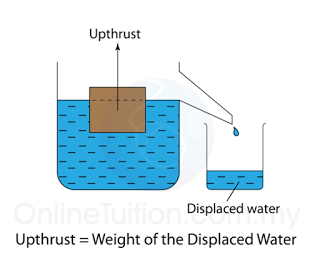
Determine the upthrust acted on the objects immerse in the water below.
a.
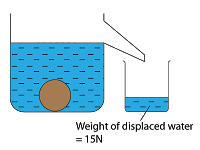
b.
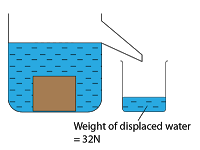
c.
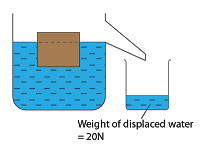
Answer:
a. Upthrust = Weight of the displaced water = 15N
b. Upthrust = Weight of the displaced water = 32N
c. Upthrust = Weight of the displaced water = 20N
Example 2:
An iron block which has volume 0.3m³ is immersed in water. Find the upthrust exerted on the block by the water. [Density of water = 1000 kg/m³]
Answer:
Density of water, ρ = 1000 kg/m³
Volume of water, V = 0.3 m³
Gravitational Field Strength, g = 10 N/kg
Upthrust, F = ?

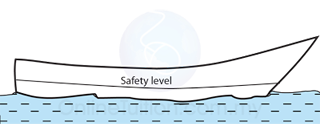
Figure above shows an empty boat floating at rest on water. Given that the mass of the boat is 150kg. Find
- the upthrust acting on the boat.
- The mass of the water displaced by the boat.
- The maximum mass that the boat can load safely if the volume of the boat at the safety level is 3.0 m³.
Answer:
a. According to the principle of flotation, the upthrust is equal to the weight of the boat.
Upthrust,
F = Weight of the boat
= mg = (150)(10) = 1500N
b. According to the Archimedes' Principle, the weight of the water displaced = Upthrust
Weight of the displaced water,
W = mg
(1500) = m(10)
m = 150kg
c.
Maximum weight can be sustained by the boat

Maximum weight of the load
= Maximum weight sustained - Weight of the boat
= 30,000 – 1,500 = 28,500N
Maximum mass of the load
= 28500/10 = 2850 kg
Example 4:
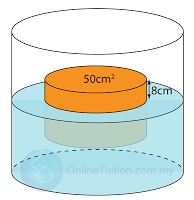
In figure above, a cylinder is immersed in water. If the height of the cylinder is 20cm, the density of the cylinder is 1200kg/m³ and the density of the liquid is 1000 kg/m³, find:
a. The weight of the object
b. The buoyant force
Answer:
a.
Volume of the cylinder, V = 50 x 20 = 1000cm³ = 0.001m³
Density of the cylinder, ρ = 1200 kg/m³
Gravitational Field Strength, g = 10 N/kg
Weight of the cylinder, W = ?

b.
Volume of the displaced water
= 50 x 12 = 600cm³ = 0.0006m³
Density of the water, ρ = 1000 kg/m³
Upthrust, F = ?

Example 5
The density and mass of a metal block are 5.0×103 kg m-3 and 4.0kg respectively. Find the upthrust that act on the metal block when it is fully immerse in water.
[ Density of water = 1000 kgm-3 ]
Answer:
In order to find the upthrust, we need to find the volume of the water displaced. Since the block is fully immersed in water, hence the volume of the water displaced = volume of the block.
Volume of the block,
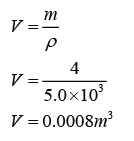
Upthrust acted on the block,
